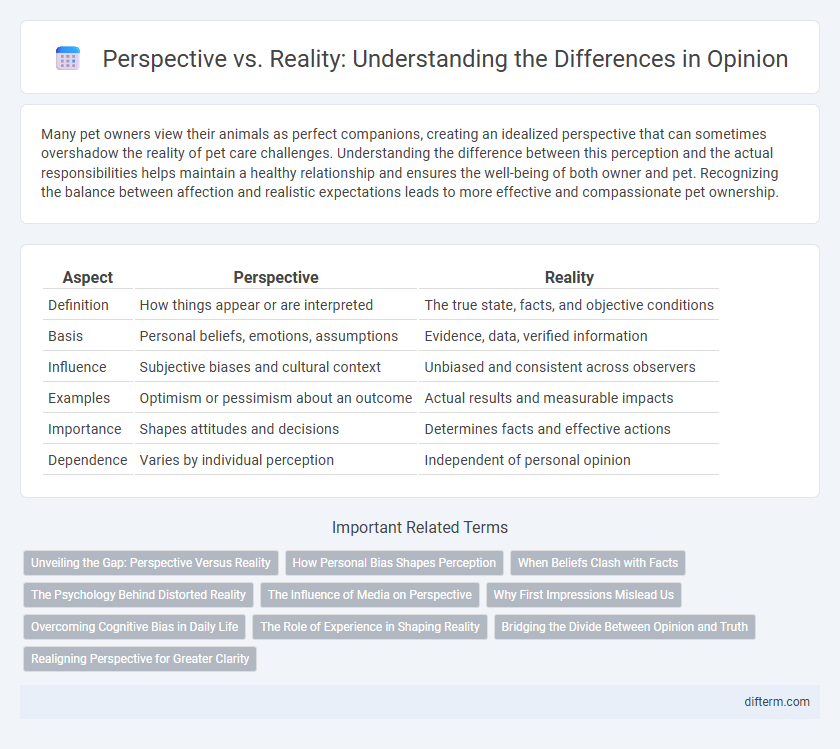Many pet owners view their animals as perfect companions, creating an idealized perspective that can sometimes overshadow the reality of pet care challenges. Understanding the difference between this perception and the actual responsibilities helps maintain a healthy relationship and ensures the well-being of both owner and pet. Recognizing the balance between affection and realistic expectations leads to more effective and compassionate pet ownership.
Table of Comparison
| Aspect | Perspective | Reality |
|---|---|---|
| Definition | How things appear or are interpreted | The true state, facts, and objective conditions |
| Basis | Personal beliefs, emotions, assumptions | Evidence, data, verified information |
| Influence | Subjective biases and cultural context | Unbiased and consistent across observers |
| Examples | Optimism or pessimism about an outcome | Actual results and measurable impacts |
| Importance | Shapes attitudes and decisions | Determines facts and effective actions |
| Dependence | Varies by individual perception | Independent of personal opinion |
Unveiling the Gap: Perspective Versus Reality
Unveiling the gap between perspective and reality reveals how cognitive biases shape individual interpretations, often distorting objective truths. Neuroscientific studies highlight that the brain filters information through emotional and experiential lenses, creating subjective realities that can diverge significantly from factual events. Understanding this discrepancy is crucial for improving critical thinking and fostering more accurate perceptions in decision-making processes.
How Personal Bias Shapes Perception
Personal bias filters experiences through individual values and beliefs, often distorting objective reality. Cognitive biases like confirmation bias and selective perception reinforce preconceived notions, shaping how events and information are interpreted. This subjective lens frequently leads to a gap between personal perspective and factual reality, influencing opinions and decision-making.
When Beliefs Clash with Facts
Beliefs often shape individual perspectives, creating a lens through which reality is interpreted, yet this subjective viewpoint may conflict with objective facts. Cognitive biases such as confirmation bias reinforce existing beliefs, making it challenging to reconcile differing perspectives with empirical evidence. Understanding the divergence between belief-driven perception and factual reality is crucial in fostering open dialogue and critical thinking.
The Psychology Behind Distorted Reality
The psychology behind distorted reality reveals how cognitive biases and emotional defenses shape individual perspectives, often leading to a divergence from objective truth. Phenomena like confirmation bias and cognitive dissonance reinforce subjective interpretations, causing the brain to filter information that aligns with personal beliefs while disregarding contradictory evidence. Understanding these psychological mechanisms is crucial for recognizing the gap between perception and reality in human behavior.
The Influence of Media on Perspective
Media significantly shapes individual perspective by selectively presenting information that aligns with specific narratives, often distorting reality. The framing techniques and repetition of particular viewpoints can create a biased perception, influencing public opinion and societal beliefs. This manufactured reality highlights the critical need for media literacy to discern fact from manipulated perspective.
Why First Impressions Mislead Us
First impressions often mislead us because the brain relies on cognitive shortcuts, such as stereotypes and heuristics, to process initial information quickly. This bias can distort reality, causing inaccurate judgments based on superficial cues rather than deeper evidence. Understanding this gap between perspective and reality is essential to foster more thoughtful and accurate evaluations.
Overcoming Cognitive Bias in Daily Life
Cognitive biases often distort our perception, causing a significant gap between perspective and reality in daily decision-making. Recognizing common biases such as confirmation bias and anchoring is essential for improving critical thinking and making more informed choices. Developing habits like seeking diverse viewpoints and practicing reflective thinking helps overcome these mental shortcuts, leading to a clearer understanding of true circumstances.
The Role of Experience in Shaping Reality
Experience fundamentally shapes individual reality by filtering perceptions through personal encounters and learned knowledge. This subjective lens alters how facts are interpreted, often causing a divergence between perspective and objective reality. Accumulated experiences provide a framework that influences decision-making, emotional responses, and belief systems, underscoring reality as a personalized construct rather than an absolute truth.
Bridging the Divide Between Opinion and Truth
Bridging the divide between opinion and truth requires critical thinking and a commitment to evidence-based analysis. Recognizing cognitive biases and verifying facts through reliable sources helps align subjective perspectives with objective reality. Encouraging open dialogue fosters mutual understanding and reduces the gap between personal beliefs and factual truth.
Realigning Perspective for Greater Clarity
Realigning perspective to embrace objective facts sharpens clarity and reduces bias, fostering more accurate understanding of reality. Recognizing the gaps between perception and truth enables individuals to challenge assumptions and adopt informed viewpoints. This shift enhances decision-making and critical thinking by grounding opinions in verifiable evidence.
perspective vs reality Infographic

 difterm.com
difterm.com